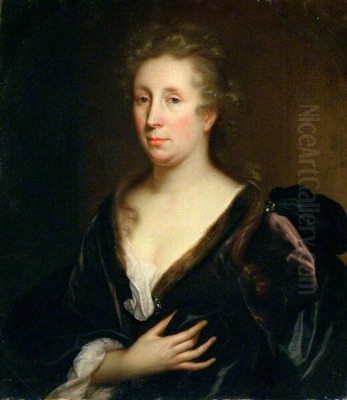
Rachel Ruysch stands as one of the most celebrated painters of the Dutch Golden Age, a period marked by extraordinary artistic production and scientific discovery. Renowned for her exquisite and highly detailed floral still lifes, Ruysch achieved international fame during her lifetime, commanding prices that surpassed even those of masters like Rembrandt. Her long and prolific career, spanning over six decades, not only cemented her place in art history but also broke significant ground for female artists in a predominantly male profession.
Early Life and Artistic Formation
Rachel Ruysch was born in Amsterdam on June 3, 1664, into a milieu rich in both scientific inquiry and artistic tradition. Her father, Frederik Ruysch, was a distinguished professor of anatomy and botany, whose work involved the creation of intricate anatomical and botanical preparations, often arranged with artistic sensibility. This environment undoubtedly fostered Rachel's keen observational skills and deep appreciation for the natural world from a young age.
Her mother, Maria Post, was the daughter of Pieter Post, a prominent architect. This connection to the arts through her maternal line further suggests a supportive atmosphere for creative pursuits. The family was affluent, providing Rachel with opportunities uncommon for women of her time. Her father's extensive collection of natural specimens – flowers, insects, shells, and preserved anatomical wonders – served as an early, invaluable resource for her artistic studies.
Recognizing her talent, at the age of fifteen, Rachel began an apprenticeship with Willem van Aelst, a leading still-life painter in Amsterdam known for his sophisticated compositions and technical prowess. Van Aelst specialized in floral pieces and hunting still lifes (`pronkstilleven`). Under his tutelage, Ruysch mastered the complex techniques required for rendering textures, capturing the play of light, and arranging elements into dynamic, yet harmonious compositions. She learned the meticulous application of paint and glazes that characterized the fine painting (`fijnschilderij`) style popular in the Netherlands.
Artistic Style and Technique
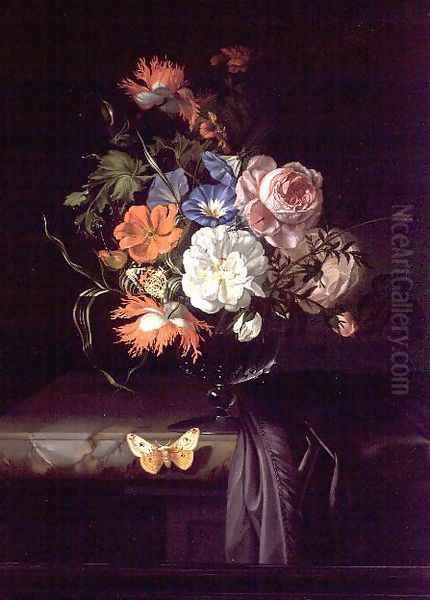
Rachel Ruysch developed a distinctive style characterized by meticulous detail, vibrant color palettes, and dramatic compositions, often set against dark, atmospheric backgrounds. Her primary subjects were flowers, fruits, and insects, rendered with almost scientific precision yet imbued with artistic vitality. She drew heavily on her botanical knowledge, depicting specific species with accuracy, often showing them in various stages of bloom and decay.
Her technique involved building up layers of thin oil glazes over a detailed underdrawing, achieving remarkable luminosity and depth. She excelled at capturing the delicate textures of petals, the sheen on leaves, the fuzz on a peach, or the iridescent wings of an insect. Dewdrops, a common motif, added a touch of ephemeral realism. Unlike the more formal, symmetrical arrangements favored by earlier flower painters like Ambrosius Bosschaert the Elder, Ruysch embraced asymmetry and dynamism.
Ruysch’s compositions often feature S-curves, creating a sense of movement and elegance. Flowers spill energetically from vases, leaves twist and turn, and insects crawl or hover among the blooms. This liveliness aligns her work with the late Baroque sensibility, while the delicacy and refinement hint at the emerging Rococo style. She masterfully employed chiaroscuro, using strong contrasts between light and shadow to model forms and create a sense of three-dimensionality, making her bouquets appear almost tangible.
Influences beyond her teacher Willem van Aelst are evident in her work. The rich complexity and abundance seen in the works of Jan Davidsz. de Heem, a master of the opulent still life, resonate in Ruysch's arrangements. She also explored the "forest floor" still life (`sottobosco`), a genre popularized by Otto Marseus van Schrieck, depicting plants, fungi, reptiles, and insects in their natural, shadowy habitats, showcasing the darker, wilder side of nature.
Major Themes and Symbolism
Like many Dutch still lifes of the period, Ruysch's paintings often carry symbolic weight, particularly relating to the theme of vanitas. The exquisite beauty of the flowers, captured at their peak, inevitably reminds the viewer of the transience of life and the fleeting nature of earthly beauty and pleasures. The inclusion of wilting petals, damaged leaves, or ephemeral insects like butterflies underscores this message.
However, her works are not solely melancholic meditations on mortality. They are also profound celebrations of nature's abundance, diversity, and resilience. The meticulous rendering of each specimen reflects the era's burgeoning scientific interest in the natural world, a field her father significantly contributed to. Her paintings can be seen as both artistic masterpieces and documents of botanical and entomological observation.
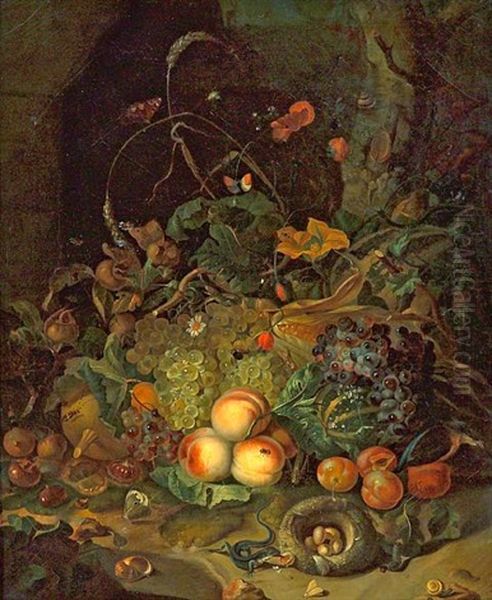
The presence of insects – bees, butterflies, beetles, snails – adds another layer of meaning and visual interest. They animate the scene, suggesting pollination, decay, and the interconnectedness of the ecosystem. Sometimes, exotic or rare flowers and shells were included, signifying wealth, trade connections, and the collector's sophisticated taste, appealing to her affluent clientele.
A Prolific and Celebrated Career
In 1693, Rachel Ruysch married the portrait painter Juriaen Pool. Remarkably, despite bearing ten children, she maintained a highly successful and prolific painting career. This achievement was exceptional for a woman in the 17th and 18th centuries, when domestic duties typically curtailed or ended professional pursuits. Her ability to balance family life with a demanding artistic practice speaks volumes about her dedication and likely the support she received from her family.
Her reputation soared throughout her long life. She produced over 250 paintings across more than six decades, continuing to paint with remarkable skill even into her eighties. Her works were highly sought after by collectors across Europe, and contemporary accounts note that her paintings commanded exceptionally high prices, often fetching between 800 and 1200 guilders – sums that reportedly exceeded what was paid for works by Rembrandt van Rijn during the same period.
This commercial success and critical acclaim solidified her status as one of the leading artists of her time, regardless of gender. Her meticulous technique and appealing subject matter resonated with the tastes of the wealthy merchant class and aristocracy who formed the primary art market in the Dutch Republic and beyond.
Patronage and Recognition
Ruysch's talent earned her significant recognition and prestigious patronage. In 1701, she and her husband Juriaen Pool became members of the Painter's Guild of Saint Luke in The Hague. More notably, Rachel was invited to join the Confrerie Pictura in The Hague, an independent society of artists often considered more elite than the traditional guild. She was the first woman admitted to this prestigious group.
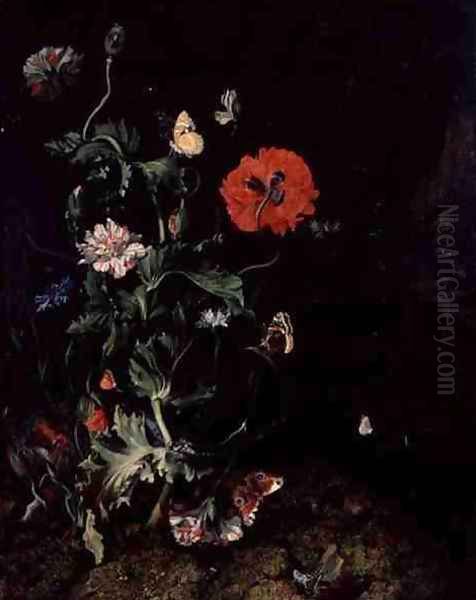
Her international reputation led to a significant appointment from 1708 to 1716. Johann Wilhelm, the Elector Palatine, named her court painter at his palace in Düsseldorf. This was a position of considerable honor and provided substantial financial security. The Elector was an avid art collector and patron. The terms of her appointment were favorable: she was not required to relocate to Düsseldorf but could remain in Amsterdam, sending one painting per year to the court. In return, she received an annual salary and was often gifted valuable items, such as a complete set of painter's equipment or silver objects, by the Elector and his wife.
Beyond the Elector Palatine, other prominent collectors acquired her work. Cosimo III de' Medici, Grand Duke of Tuscany, visited Amsterdam and purchased several paintings, including a significant still life now housed in the Uffizi Gallery in Florence. This patronage from European nobility underscores the widespread appeal and high regard for her artistry.
Representative Works
Several key works exemplify Rachel Ruysch's style and mastery:
_Flowers in a Vase_ (c. 1706, Kunsthistorisches Museum, Vienna): This painting showcases her mature style. A dynamic bouquet bursts from a glass vase, featuring a variety of flowers like roses, tulips, poppies, and carnations. The composition is complex and asymmetrical, with flowers depicted in different stages of life. Insects crawl on leaves and petals, adding minute detail and life. The dark background and dramatic lighting highlight the vibrant colors and textures of the flora.
_Still-life with Flowers, Fruit, and Insects_ (c. 1711/1716, Uffizi Gallery, Florence): Likely one of the works acquired by Cosimo III de' Medici, this painting combines flowers with fruit like grapes and peaches, alongside various insects. It demonstrates Ruysch's skill in rendering diverse textures and surfaces, from the velvety skin of the fruit to the delicate transparency of insect wings. The arrangement feels naturalistic yet carefully composed, embodying the blend of scientific observation and artistic elegance typical of her work.
_Bouquet on a Marble Tabletop_ (1716, Rijksmuseum, Amsterdam): Painted during her time as court painter, this work exemplifies the richness and complexity she achieved. Set against a dark background, an opulent bouquet overflows from an unseen vase onto a marble ledge. The variety of flowers is impressive, rendered with exquisite detail and vibrant color. The play of light on the petals and the inclusion of small creatures create a scene teeming with life, while the marble ledge adds a touch of classical solidity.
These works, among many others, demonstrate her consistent ability to create visually stunning and technically brilliant paintings that captivated her contemporaries and continue to impress viewers today.
Context: Contemporaries and the Art Market
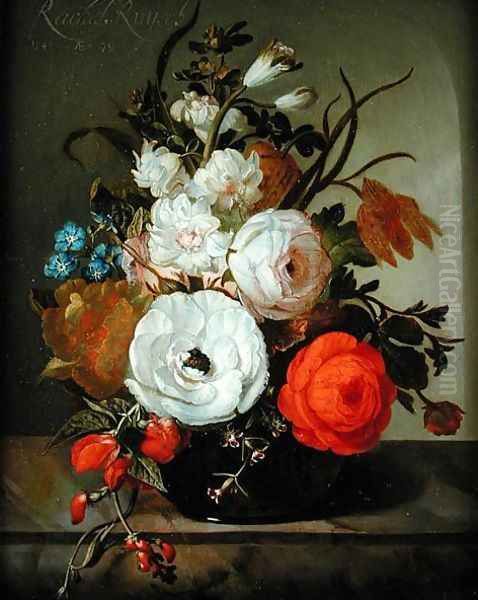
Rachel Ruysch worked during the later phase of the Dutch Golden Age, a period that saw the flourishing of artists like Johannes Vermeer and Jan Steen, though their focus differed greatly from hers. Within the specialized field of still life, she was a dominant figure. Her teacher, Willem van Aelst, was a major influence, and she built upon the traditions established by earlier flower painters like Ambrosius Bosschaert the Elder and Jan Davidsz. de Heem.
Her most direct contemporary and potential rival in floral painting was Maria van Oosterwyck (1630-1693). Both women achieved significant success specializing in detailed flower pieces, and both studied, at least for a time, with Willem van Aelst. While direct evidence of their personal relationship is scarce, they operated within the same artistic circles and competed for similar patrons. Both commanded high prices, indicating a healthy market appreciation for female artists specializing in this popular genre. Ruysch's career, however, extended much longer and arguably achieved wider international renown, particularly through her court appointment.
Other contemporaries included portraitists like Frans Hals (though he died when Ruysch was young) and her husband, Juriaen Pool. The comparison of her prices to Rembrandt highlights her exceptional market success. Her work stands apart from the genre scenes of Jan Steen or the tranquil interiors of Vermeer, showcasing the incredible specialization that characterized Dutch Golden Age art.
Breaking Barriers: A Woman in a Man's World
Rachel Ruysch's career is a remarkable story of female achievement in a field largely dominated by men. While other women artists, such as Judith Leyster, also gained recognition during the Dutch Golden Age, Ruysch's sustained success over such a long period, her international fame, court appointment, and documented high earnings place her in a unique position.
Her ability to successfully combine the roles of wife, mother of ten, and highly productive professional artist challenged contemporary norms. It suggests not only immense personal drive and talent but also a supportive family structure and effective management of her time and resources. She navigated the art market shrewdly, leveraging her skills and connections to build a lasting reputation.
Her success provided an important precedent and potential inspiration for subsequent generations of female artists. She demonstrated that women could achieve the highest levels of artistic mastery and professional recognition, contributing significantly to a major European art movement.
Legacy and Influence
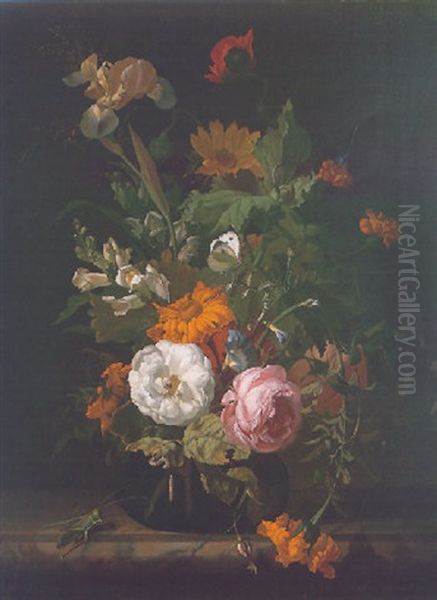
Rachel Ruysch died in Amsterdam on October 12, 1750, at the advanced age of 86, having actively painted almost until the end of her life. Her legacy is multifaceted. Artistically, she perfected the floral still life, bringing a new level of dynamism, detail, and emotional resonance to the genre. Her techniques in rendering texture, light, and color set a high standard, influencing subsequent still-life painters in the Netherlands and beyond well into the 18th century.
Her paintings remain highly prized by museums and collectors worldwide. They are studied for their technical brilliance, their botanical accuracy, and their embodiment of late Baroque and early Rococo aesthetics. Major institutions like the Rijksmuseum in Amsterdam, the National Gallery in London, the Uffizi Gallery in Florence, and the Kunsthistorisches Museum in Vienna hold significant examples of her work.
Beyond her artistic contributions, Rachel Ruysch holds an important place in the history of women artists. Her long, successful, and well-documented career serves as compelling evidence of female artistic talent and professional capability during a period when such opportunities were limited. She remains a key figure in the Dutch Golden Age, celebrated not just as a master of still life, but as a trailblazer who achieved enduring fame through her exceptional artistry and perseverance.